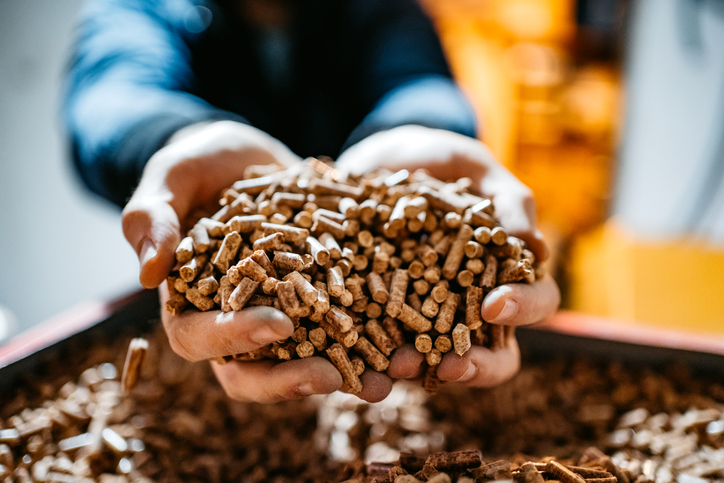You can manage your cookie preferences in the sections below. If you would like to know more, please view our privacy & cookie policy.
A guide to biomass heating for your home
Biomass is a type of organic matter, often referred to as 'bioenergy' or 'biofuel', which is used as an alternative, green source of energy.
Biofuels are produced from organic materials, either directly from plants or indirectly from industrial, commercial, domestic or agricultural products. These materials fall into two main categories:
- Woody biomass includes forest products, untreated wood products, energy crops, and short rotation coppice (SRC), e.g. willow.
- Non-woody biomass includes animal waste, industrial and biodegradable municipal products from food processing, and high energy crops, e.g. sugar cane and maize.

Can you use biomass to heat your home?
For small-scale, domestic applications, biomass heating systems are usually fuelled through the use of wood pellets, wood chips and wood logs.
There are two main ways of using biomass to heat a domestic property:
Standalone stoves
Standalone stoves can be fuelled by logs or pellets, but only pellets are suitable for automatic feed. Generally they are 6-12 kW in output, and some models can be fitted with a back boiler to provide water heating.
Many wood burning stoves act as space heaters only, but the higher output versions can be fitted with an integral back boiler to provide domestic hot water and central heating through radiators, if needed.
Boilers
There are many domestic log, wood-chip and wood pellet burning central heating boilers available that can be connected to central heating and hot water systems.
Log boilers can be used as a link in system to the more traditional gas and oil boilers. They are ideal for giving you a secondary source of heating and for helping to reduce the reliance on fossil fuels. As logs are fairly available, you can heat your homes without running into much trouble and pay little to no fuel costs as a bonus.
Wood pellet boilers are a good all year-round solution. Though they won’t win many beauty contests, they can be used as a stand-alone boiler without you having to fiddle around with it much. It has a more ‘set in and forget it’ approach, but it comes at a price.
Boilers can be designed with an integral hot water energy storage or accumulator tank that stores water up to 90ºC, enabling the supply of heat to be further decoupled from the combustion of the fuel.
What if my boiler breaks down?
A boiler breakdown is probably not something any of us consider until it’s too late – this video explains what to do if your boiler breaks down.Is your house suitable for a biomass heating system?
You should consider the following points if you're thinking about installing a biomass boiler or stove in your home:
- Fuel - It's important to have storage space for the fuel, appropriate access to the boiler for loading, and a local fuel supplier.
- Flue - The vent material must be specifically designed for wood fuel appliances, and there must be sufficient air movement for proper operation of the stove.
- Regulations - The installation must comply with all safety and building regulations your home might be governed by.
- Smokeless zone - Wood can only be burnt on exempted appliances, under the Clean Air Act.
- Planning - If the building is listed or in an area of outstanding natural beauty (AONB), then you will need to check with your Local Authority Planning Department before a flue is fitted.
An accredited installer will be able to provide more detailed advice on whether any of the above applies to your property.
How much does a domestic biomass system cost?
You may have got to this point and wondered something along the lines of “how much does a biomass boiler cost?”. If so, we have you covered. To work out the costs of a ground source heat pump, you need to break down all the costs involved, including:
What are the initial costs of a biomass heating system?
This will depend on the type and size of system you choose, but installation and commissioning costs tend to be fairly fixed.
Standalone room heaters generally cost between £1,500 - £3000 for purchase and installation. The cost for boilers varies depending on the fuel choice; a typical 20kW (average size required for a three-bedroom semi-detached house) pellet boiler would cost around £5000 installed, including the cost of the flue and commissioning. A manual log feed system of the same size would be slightly cheaper.
What are the running costs of a biomass heating system?
Unlike other forms of renewable energy, biomass systems require you to pay for the fuel. Fuel costs generally depend on the distance your home is from your supplier.
As a general rule, the running costs will be more favourable if you live in an area that doesn't have a gas supply.
Can you make money back on a biomass system?
This depends on the fuel being replaced and the type of wood fuel being used. As is the case with most other aspects of biomass installations, the ‘cashback’ is more favourable in areas that don't have a gas supply.
What are the benefits of biomass heating?
Producing energy from biomass has both environmental and economic advantages. It is most cost-effective when a local fuel source is used, which results in local investment and employment.
With the prices of traditional energy continuing to increase and with no sign of stopping, using biomass as the source of heating is a much more cost-efficient solution long term. This is because the cost of your heating is no longer reliant on the fluctuations of energy prices. No more energy price cap headaches!
Furthermore, biomass can contribute to waste management by harnessing energy from products that are often disposed of at landfill sites.
